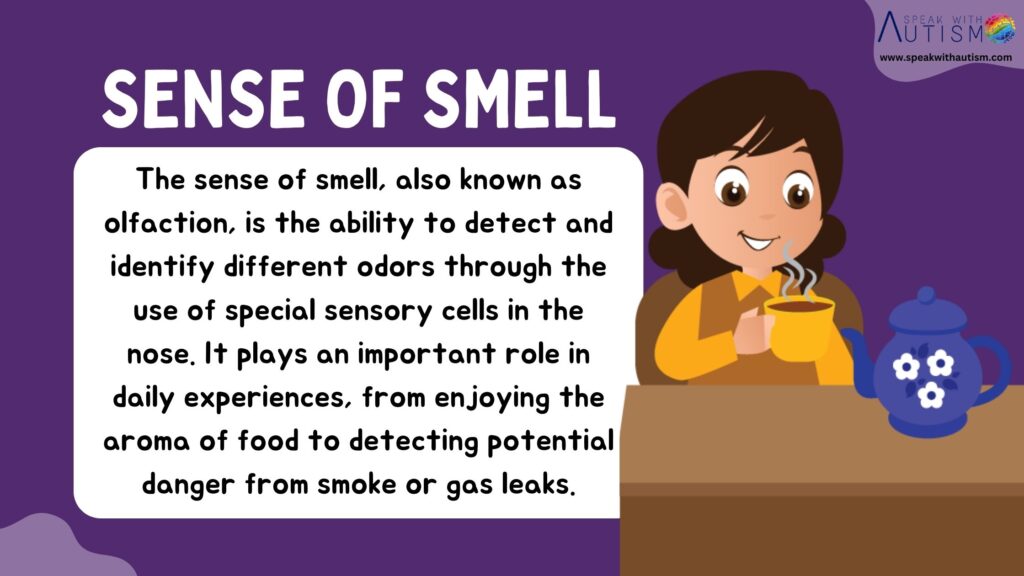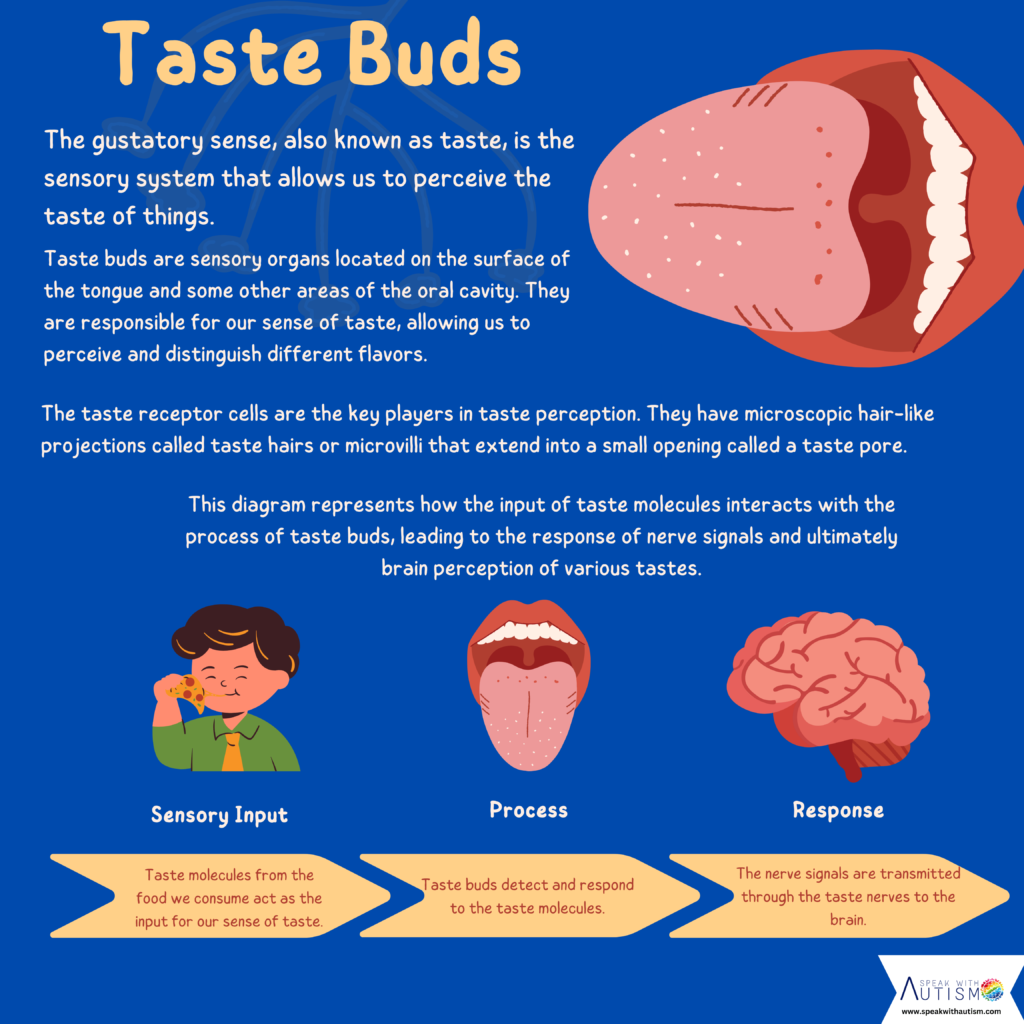Today, we will talk about “Taste and Smell Sensory Issues”. Have you noticed that your child cannot tolerate small things, like eating on a plate or smells that come while cooking? Smells that seem normal to us, he cannot tolerate them. Or he experiments with certain things so much that he wants to put everything in his mouth, whether edible or non-edible. If you have noticed something like this, it could be a sign of a sensory processing disorder related to taste and smell. How can we deal with this at home? Today, we will talk about this. Smell and taste sensory issues: How can we identify and help at home?
Table of Contents
Olfactory and gustatory senses (Taste and Smell Sensory Issues)

Olfactory sense allows us to differentiate and identify different smells, that is, to identify different smells and understand which object they may be related to.
Taste sense is related to our tongue. Tongue has sensory receptors which help us to identify the texture, temperature and taste of food. Olfactory and gustatory senses together decide which food we will taste and which we will not.

You must have noticed that if we don’t like the aroma of something, then we don’t like to taste it either. The same happens with children too. When they have olfactory and gustatory sensory processing disorders, the coordination of their brain and body doesn’t work properly, due to which behavioral issues are visible.
Difference between Hyper-sensitive and under-sensitive cases
Hyper-sensitive (Over-responsive)
- The child is very responsive in matters of smell and taste.
- He is very choosy about food.
- Does not like to even see some specific food items on his plate.
- Cannot even tolerate touching and smelling them.
Parents think that the child is a picky eater, but in reality, their senses are over-responsive. They are not able to communicate this.
Under-sensitive (Under-responsive)
- The child needs exposure to different smells.
- They smell everything, whether it is edible or non-edible.
- Sometimes this seems inappropriate in social situations.
- Some children put non-edible items in their mouth to explore different textures.
What is important in Taste and Smell Sensory Issues?
It is important to teach children to adapt, otherwise these challenges can increase in their normal living.
In hyper-sensitive cases
- If the child avoids many things, it can lead to nutritional deficiency.
In under-sensitive cases
- If the child cannot identify smells and tastes, he can taste harmful things.
In both these cases, to overcome the sensory challenges, some activities should be done at home that improve the sensory processing of children.
Understanding and Managing Hypersensitivity in Kids: Strategies and Activities
1. Meal Time as Fun Time
Hypersensitive children can feel overwhelmed by food smells and textures, making mealtime stressful. Here are some strategies:
- Make Mealtime Fun: Turn it into a game. For example, pretend the food is an airplane and make it “fly” into their mouth. Or create stories, like Spider-Man delivering the food.
- Present Food Creatively: Arrange food on the plate in colorful, engaging ways. For example, use ketchup to draw a smiley face on bread.
- No Forcing: Never force your child to finish their plate. Let them enjoy the experience of eating at their own pace.
2. Introducing Different Smells
Since hypersensitive kids struggle with smells, gradual exposure is key:
- Grocery Store Visits: Take your child shopping. Let them touch and explore different foods with mild aromas.
- Involve Them in the Kitchen: Start by allowing them to observe you, then gradually involve them in simple tasks like washing vegetables or stirring. This exposure helps them adapt to different smells.
3. Scented Activities
- Scented Jars: Fill small transparent jars with rice. Add 1-2 drops of calming scents like vanilla or lavender initially. Gradually introduce stronger scents like citrus or peppermint.
- Scented Markers and Playdough: Let them color or play with scented tools to enhance fine motor skills while subtly introducing different smells.
4. Food Games
- Place preferred and new food items in separate plates. Roll a dice to decide which food to interact with. Start by just touching the new food, then progress to smelling and eventually tasting it.
- Always introduce small quantities of new food and place them alongside familiar ones. Encourage, but don’t force.
5. Blowing Activities
To strengthen oral motor skills and sensory regulation, try:
- Blowing bubbles in water using a straw.
- Balloon-blowing or candle-blowing activities.
These exercises also help with eye contact and sensory stimulation.
6. Recognizing Smells
- Take your child to the kitchen and let them smell spices like cloves or cardamom. Turn it into a guessing game by blindfolding them and asking them to identify the spice.
- Introduce distinct-smelling flowers, like roses, to enhance their olfactory recognition.
7. Exploring Textures
- Start with crunchy textures like roasted fox nuts, coconut pieces, or banana chips.
- Gradually introduce intense flavors, like lemon or curry leaves, by combining them with familiar foods.
8. Oral Motor Stimulation
- Use a vibrating toothbrush to gently stimulate their oral muscles.
- Incorporate oral massages or specific oral-motor exercises recommended in speech therapy.

These gradual, engaging, and empathetic methods can help your child adapt to different sensory experiences and reduce hypersensitivity. Patience and consistency are key!
Frequently Asked Questions (FAQ’s)
Does your child try to put everything in his mouth or taste it, whether it is edible or not?
This can be a sign of under-responsive (hyposensitive) behaviour. Such a child seeks more exposure to smells and tastes.
Does your child not like to put a particular type of food on the plate?
This can be a sign of hypersensitivity. Such a child may be bothered not only by the smell of food but also by its texture and colour.
Does your child try to smell everything new?
This can be a sign that the child is looking for new aromas and his sensory processing is not working properly.
Ways to manage sensory processing disorder at home?
Give gradual exposure:
Gradually introduce new smells to hypersensitive children.
Start with things with mild and soothing smells while cooking.
Olfactory games:
Play recognition games, such as giving the child the smell of fruits, flowers, or spices and asking them to identify the names.
Gustatory activities:
Give small pieces of food and ask the child to identify whether it is sweet, sour, or bitter.
Experiment with smells and textures:
If the child is under-responsive, introduce him to aromatherapy (such as lavender, and lemon) and foods of different textures.
Use visual and auditory aids:
Use pictures and music to give children information about smells and tastes.
Counseling and practice:
Gently teach both types of children that it is important to adopt every new thing.
